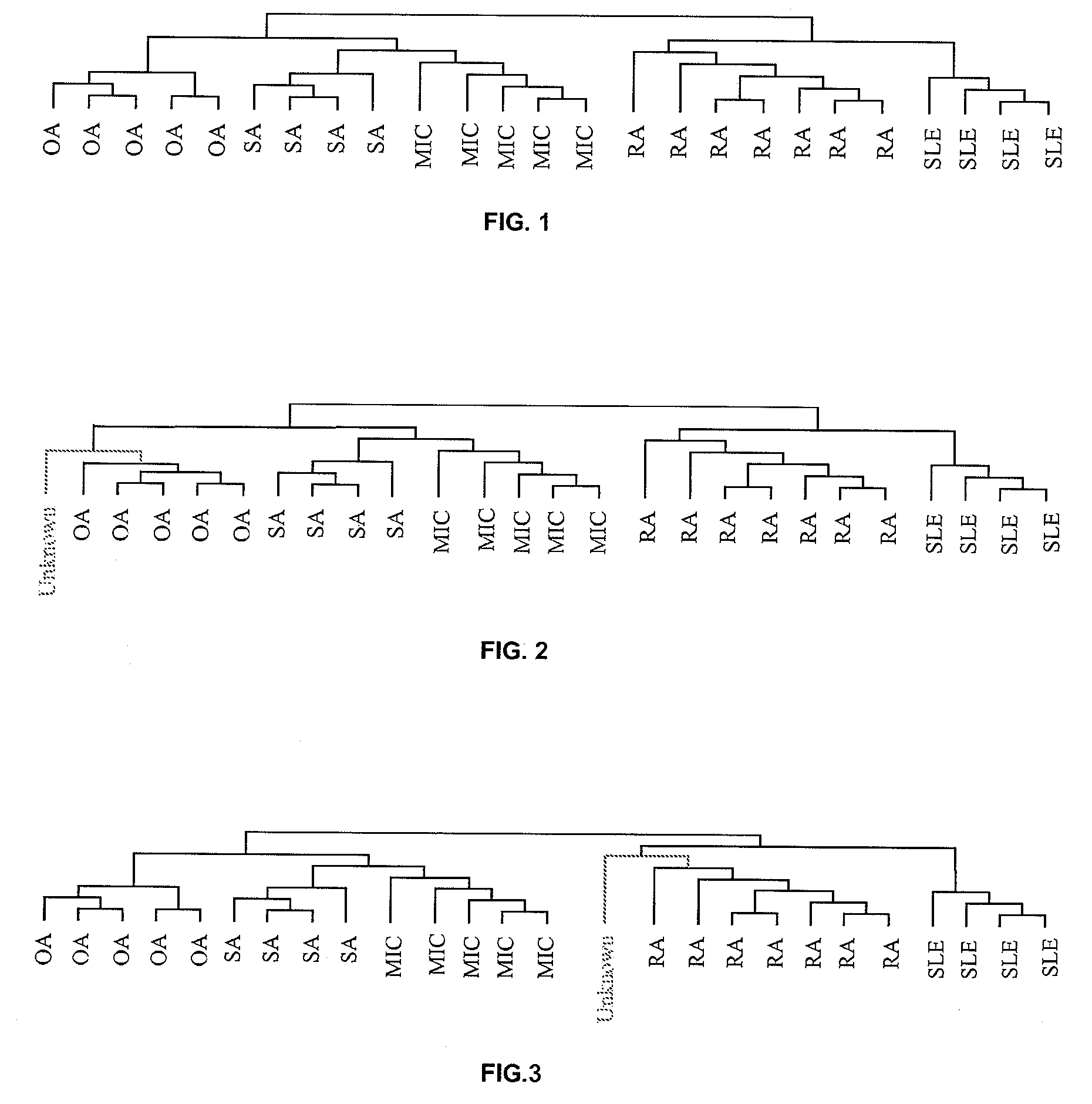Method for the determination and the classification of rheumatic conditions
a rheumatic disorder and classification technology, applied in the field of rheumatic disorder determination and classification, can solve the problems of difficult to distinguish between these disorders and inconvenient observation in daily medical practi
- Summary
- Abstract
- Description
- Claims
- Application Information
AI Technical Summary
Benefits of technology
Problems solved by technology
Method used
Image
Examples
example 1
Identification of Distinct Molecular Signatures Characterizing the Five Disorders: SLE, RA, OA, SA and MIC
[0131]Patients and Synovial Biopsies:
[0132]Synovial biopsies were obtained by needle-arthroscopy from the knee of patients with SLE (n=4), RA (n=7), OA (n=5), MIC (n=5) and SA (n=4). For each patient, 4 to 8 synovial samples were snap frozen in liquid nitrogen and stored at −80° for later RNA extraction. The same amount of tissue was also kept at −80° for future immunostaining experiments on frozen sections. The remaining material was stored in formaldehyde and paraffin embedded for conventional optical evaluation and immunostaining of selected cell markers. All SLE patients met the American College of Rheumatology (ACR) revised criteria for the diagnosis of systemic lupus; they all were females and were average 32.0 year-old (range 19-40 year). All of them had active articular disease at the time of synovial tissue sampling. None of the SLE patients was treated with immunosuppr...
example 2
[0139]A 53-year-old female patient presented with arthritis of both knees. X-rays and MRI showed severe degenerative changes of the internal femoro-tibial compartment and a severe inflammatory thickening of the synovial tissue. Biological work-up identified the presence of anti-citrulline antibodies in the serum of the patient, a marker that is associated with rheumatoid arthritis. Her rheumatologist hesitated between a diagnosis of severe OA versus atypical RA. A synovial biopsy was performed at that time.
[0140]RNA was extracted, labeled according to the Affymerix procedure described above and hybridized on a GeneChip® Human genome U133 Plus 2.0 Array. Data were retrieved on GCOS software for the initial normalization and analysis steps. The normalized data from this sample were used for a supervised clustering study on TMEV, together with the 25 reference samples from example 1, using the specific selection of genes listed in Table 2 or 3.
[0141]The results of that experiment are s...
example 3
[0142]A 58-year-old male patient presented with chronic inflammatory knee arthritis. Synovial fluid examination had shown the presence of an inflammatory cell population (>4,000 elements / mm3); X-ray studies were not contributive. Because of the presence of an atypical rash, his rheumatologist questioned the possibility that the patient suffered from seronegative (psoriatic) arthritis. Synovial biopsies were taken by needle-arthroscopy, RNA was extracted, labeled according to the Affymerix procedure described above and hybridized on a GeneChip® Human genome U133 Plus 2.0 Array. Data were retrieved on GCOS software for the initial normalization and analysis steps. The normalized data from this sample were used for a supervised clustering study on TMEV, together with the 25 reference samples from example 1, using the specific selection of genes listed in Table 2 or 3. The results of the clustering study indicated that his synovial tissue did not cluster with SA samples, but with RA syn...
PUM
| Property | Measurement | Unit |
|---|---|---|
| density | aaaaa | aaaaa |
| Euclidean distance | aaaaa | aaaaa |
Abstract
Description
Claims
Application Information
 Login to View More
Login to View More - R&D
- Intellectual Property
- Life Sciences
- Materials
- Tech Scout
- Unparalleled Data Quality
- Higher Quality Content
- 60% Fewer Hallucinations
Browse by: Latest US Patents, China's latest patents, Technical Efficacy Thesaurus, Application Domain, Technology Topic, Popular Technical Reports.
© 2025 PatSnap. All rights reserved.Legal|Privacy policy|Modern Slavery Act Transparency Statement|Sitemap|About US| Contact US: help@patsnap.com

